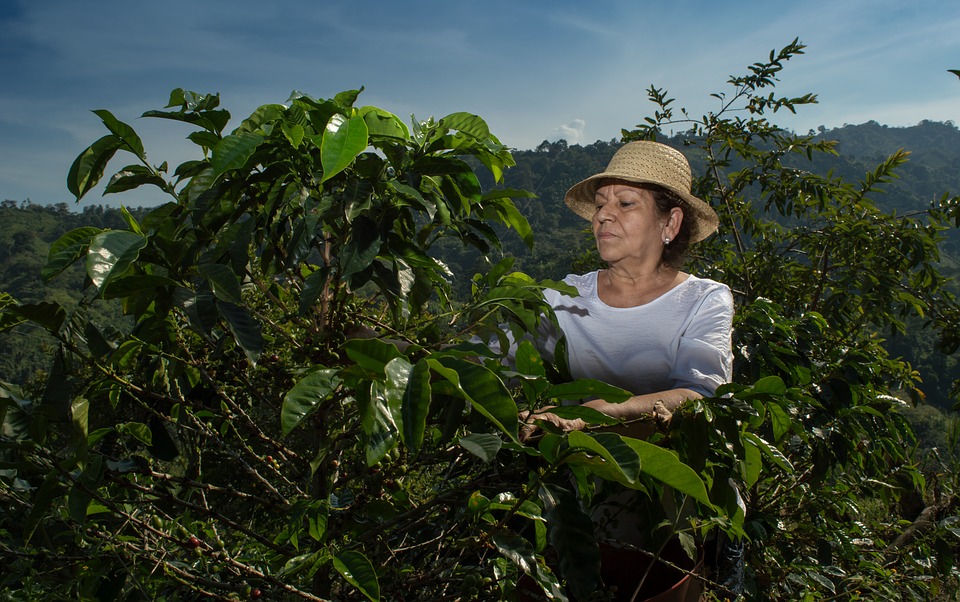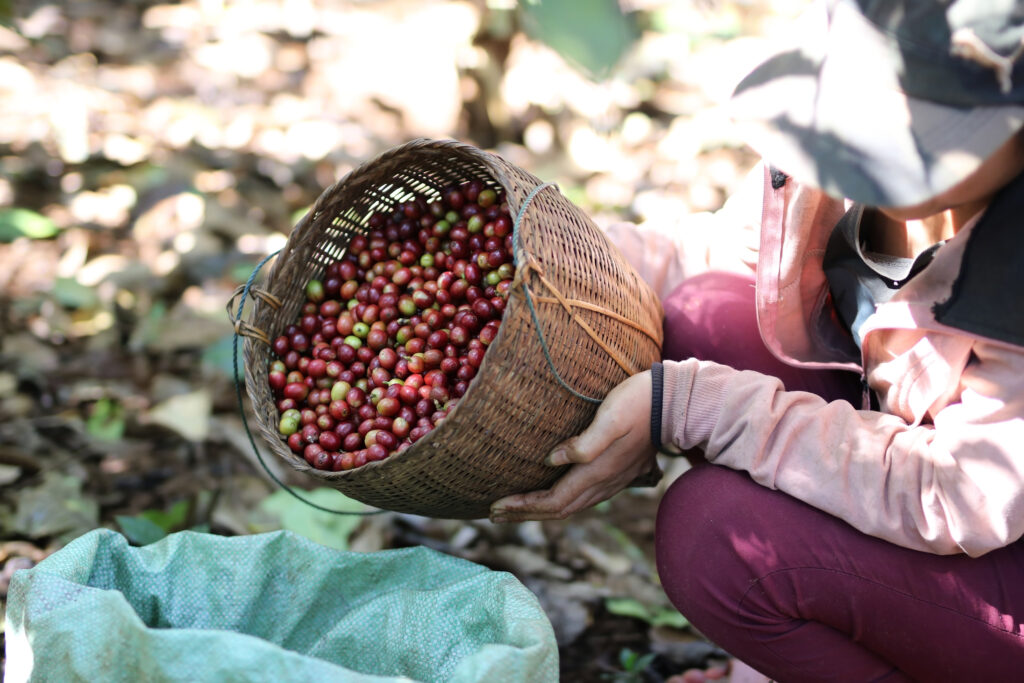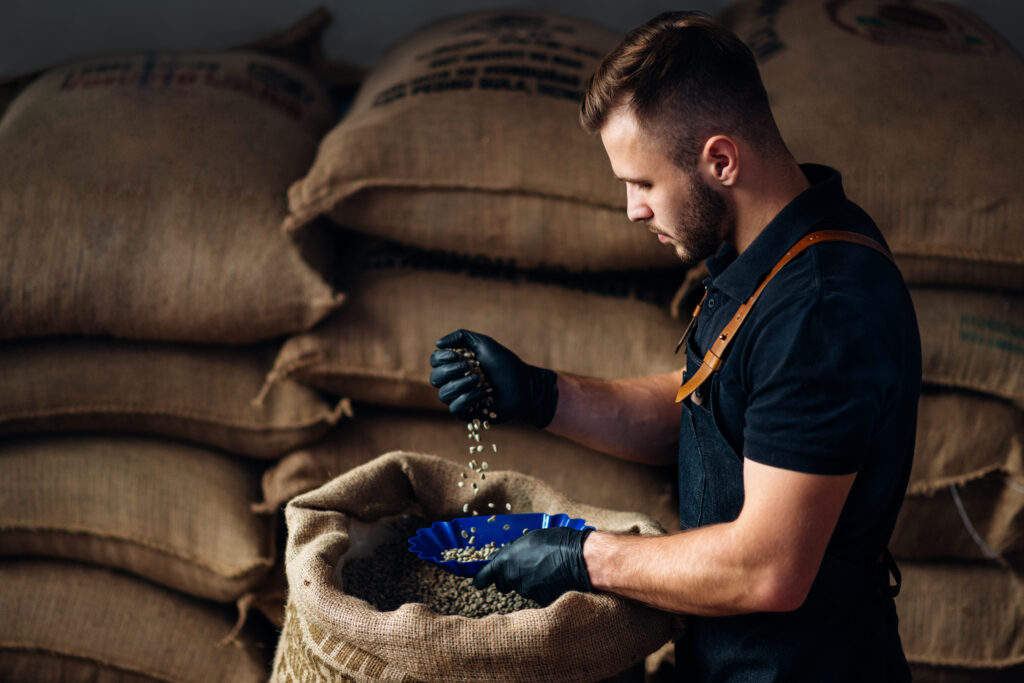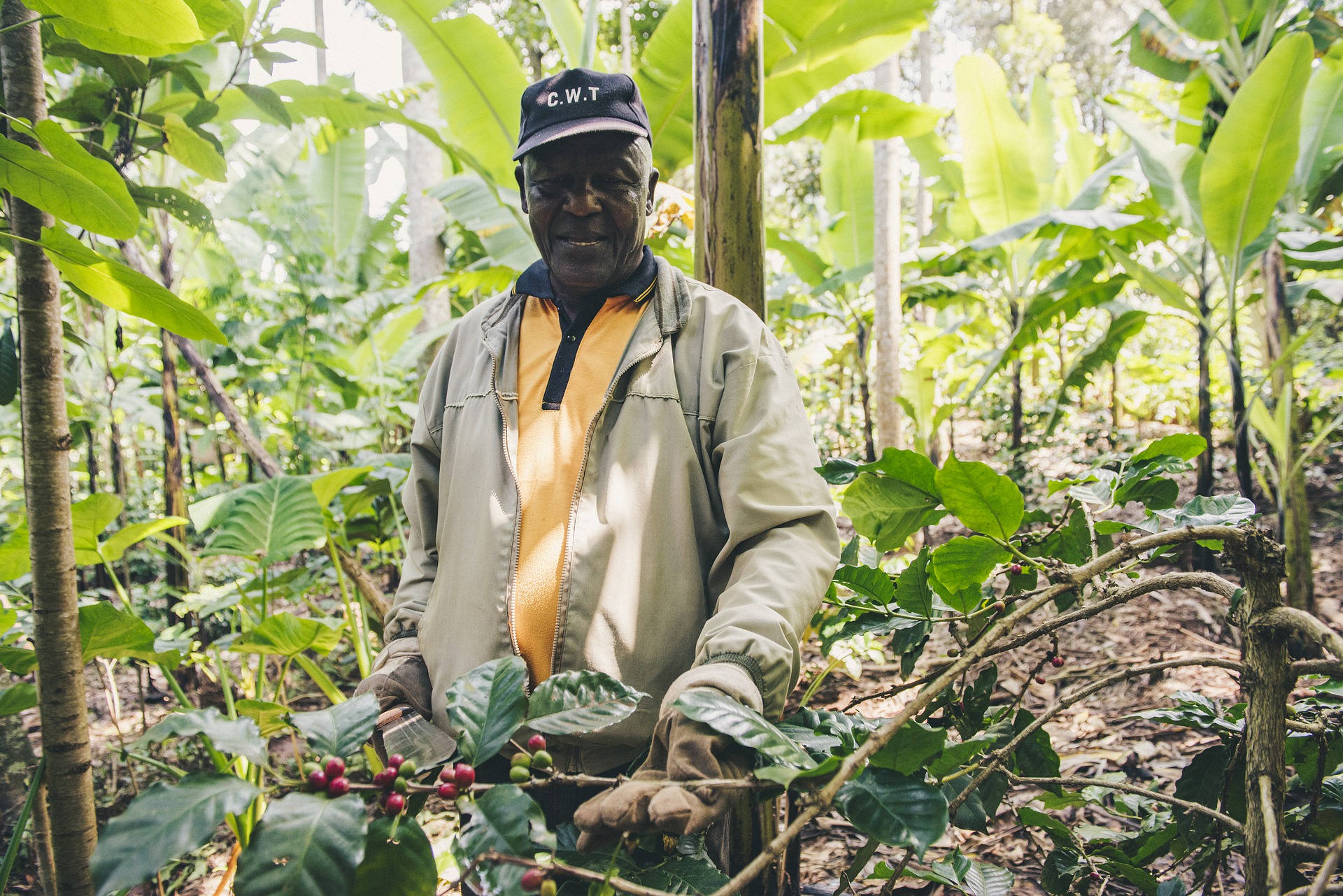You can buy a 250 gram coffee bag for several zlotys or for over a hundred zlotys. Where does this price span come from and what are the factors which shape the final price of coffee?
Global Coffee Supply Chain
Coffee gets to a store or a café many months after it was harvested at the plantation. What’s more, raw coffee beans are not delivered to the roaster by a courier service, as is the case with online shopping. For the green coffee to get to the roaster, it needs to be part of a supply chain, that is a process which transforms the coffee cherries into roasted coffee beans. The supply chain differs depending on the country of origin or the scale of production, but in most cases it looks like this:
GLOBAL COFFEE SUPPLY CHAIN
- FARMER
- Cultivation
- Harvest
- Processing
- Milling
- Packaging
- Exporter
- Sending out samples
- Loading coffee into containers
- Preparing export documentation
- Loading the container onto the ship
3. Importer
- Sea / air freight
- Receiving coffee at the destination port
- Customs procedures
- Transport to the warehouse and storage
- Delivery to the client (roasters)
- Roasters
- Coffee roasting
- Packaging
- Delivery to the customer (café / shop / retail customer)
- Café / shop / consumer
Brewing / selling coffee to the consumer
- This simplified coffee supply chain involves hundreds of people in several countries on various continents and makes the global coffee trade possible. Of course, there are ways to shorten it and sometimes the farmer and the exporter, or the exporter and importer are the same party, and in the case of global brands the whole supply chain is in the hands of one entity. Every participant of this complex process performs tasks charged with money, and the sum of these charges is paid at the end by the target recipient. And this is where we reach the key issue.
Which part of the retail coffee price gets directly to the farmer?
The answer is both very simple and quite complex:
It depends.

Global Turnover of Coffee
Knowing that coffee goes through so many hands before it is brewed, we should look at its journey from an economic perspective. The absolute majority of coffee in the world is treated as commodity, that is a product with certain qualities that make it distinct and, if necessary, allow to replace it with another product with the same parameters. In other words, it should be possible to replace the sack with coffee from Brazil of NY2/3 with another coffee from Brazil with the same parameters, and there should be no perceptible difference in taste. Such approach to coffee makes enables the global trade and future contracts, that is buying and selling coffee that has not been produced yet. The price of coffee at the stock market is fluid and changes like exchange rates or the price of gold. The C price, that is the market price of coffee is a parameter which defines the value of raw material similar to the one which determines, e.g. the price of a barrel of oil. The trade takes place on the exchange markets in New York (arabica) and in London (robusta). So, it is possible to make a contract in 2019 for the purchase of 100 tons of coffee at a set price, which will be delivered in 2021. Thanks to this, taking advantage of the low price of coffee at a given time, you can gain on the increase of its value over time and, e.g. in 2020 trading the contract at a higher price, making money from coffee that has not even been produced yet. Because of this type of trade, there is much more coffee on the market than there is physically in stock. It can lead to many dangerous market crises.
The C price determines the basic price of coffee and is the foundation for calculating prices of coffees from different countries and of higher quality based on the so-called differentials. Not going into details, the prices of almost all coffees produced around the world depend on this parameter.
The C price is the price of 1 pound (453 g) of green coffee expressed in American dollars (USD). So, if the coffee price is 1.2 USD/lb, it means that we pay USD 2.64 per 1 kilogram of coffee.
The C price is the price paid for coffee at the point of its loading onto the ship, that is including the price for the farmer and the exporter. This price is called FOB, which means ‘free on board’. As of this moment, the coffee belongs to the importer, who covers the prices of transport, insurance, customs, unloading and transport to the warehouse, as well as storage, samples for the roastery etc.
Having included those costs, the importer puts a price on coffee and sells it to roasteries. This price is called EXW (ex-warehouse), which means the price of coffee which left the warehouse. The buyer – roastery – pays for coffee and the costs of transport.
The final step is, of course, roasting coffee, packaging and transporting to a café / a store. At this stage we talk about recommended retail price, that is RRP.
What percentage of the retail price do individual participants of the supply chain receive? Let’s look at the example below:
In this example, the retail price of 1 kilogram of coffee is PLN 100 net, that is PLN 123 gross. Assuming that the café / the store buys coffee from the roastery at the price of PLN 70 net per kg, the roastery earns PLN 54 from every kilogram. Bear in mind, it is only revenue, not the income (!) and this amount covers employee costs, media, leasing, amortisation, packaging, marketing, transport etc.
The most interesting fact is that the produced gets PLN 12, that is about USD 3 per each sold kilogram of coffee. Having deducted production costs of about USD 2.5 per kg the farmers get USD 0.5 from each kilogram of coffee they produced. This is the price of specialty coffee with a score of about 80-82 points in SCA scale, originating from South America. Assuming that the coffee yield in a given harvest was 10 tons, the farmer’s profit will be USD 5,000, that is PLN 19,200, which gives PLN 1,600 per month. The costs of interest rates on loans, amortization, investment in equipment, infrastructure etc. are not included. And in the end, you simply need to make a living – feed your family, send children to school and try to save for retirement because the pension in Central America is even lower than in Poland, and the costs of living are quite similar.
We have assumed the FOB price at 1.73 $/lb, while the current C price is about 1$/lb. With production costs at 1.25 $/lb, the production is not economically viable.

Global Crisis of Coffee Prices
Now we get to the heart of the matter, that is record low prices of coffee in the world. Considering inflation, we are currently facing the lowest prices of coffee in history. They are not only record low, but they don’t even cover the production costs of coffee, so the farmers actually sell the fruits of their labour at a loss. It’s easy to figure out where things are heading.
So, where did this whole crisis come from? It should be noted that there has been many rises and drops in coffee prices caused by many factors: the weather, political turbulence, global economic crises etc. However, the price drop has never been as serious and long-standing as now. There are several reasons for that.
- Coffee demand is quite stable, which cannot be said about coffee supply. In 2018 the biggest coffee producer in the world, Brazil, produced record yield from a hectare, which led to a surplus of coffee available on the market. And if supply is higher than demand, the price naturally begins to drop.
- Another factor was weakening of the Brazilian real due to insecure political situation before presidential election at the end of 2018, which additionally decreased the price of coffee traded in American dollars.
- Another important factor is speculation. The already mentioned future contracts are a price-shaping tool. If speculators notice the downward trend, they begin to sell contracts hoping that it will be possible to buy them back at a lower price after a few weeks. More contracts sold = more virtual coffee in trading = even lower price. At this point, speculation acts like a self-fulfilling prophecy and leads to a further drop in prices.
The described sequence of events took place between July and September of 2018 and led to the drop of C price below 1 $/lb, which was a breaking point for a certain psychological barrier on the market. You should know that the prices of coffee were already low but those three key months led to the situation we’re currently facing.
Coffee producers live from harvest to harvest and their welfare, and often sheer survival, are fully dependent on the size of the crop, its quality and prices on global markets. We can actually say that their fate is not in their own hands – after all, they have no impact on rainfall, global warming or the C price. For this reason, coffee production becomes less and less viable and many producers give up and switch to more lucrative plants, like avocado, bananas or coca leaves. Mind you, this is the most positive scenario, because many of them lose or abandon their plantations and move to large cities or abroad in order to make a living. What is more, it is difficult to convince another generation to take over farms and work in coffee industry. The young don’t see any prospects in it, so they turn into service sector or, oftentimes, criminal underworld. The situation is even more tragic in the African countries, where the yield per hectare is far lower than in Brazil or Vietnam.

There is a conflict of interest, of course, because we should all enjoy low coffee price, shouldn’t we? The advantage is illusory because in the long run the number of producers will drop and global warming will lead to new problems with production, which may cause a slump in production and a huge price rise. One can say that it is simply another economic cycle, but we’re talking about the life of 21 million of coffee-producing families all over the world. If they don’t make money from it and slide into poverty whereas we enjoy cheap coffee in posh cafés, do we really want to be part of that?
Specialty Coffee as a Way to Survive the Times of Crisis
The situation described concerns mainly the producers of cheap commodity coffee and the like, sold at the C price. Specialty coffee is not completely independent of the C price, but in most cases the price is negotiable between the farmer and the buyer. In this trading system, the price of product depends mostly on its quality and quantity and is less susceptible to fluctuations resulting from the global economic turbulence.

The world of specialty coffee noticed the problem of dropping coffee price already a few years ago, and some importers or coffee roasteries decided to focus on transparent purchasing terms, based on the simple and old-fashioned idea of honesty. Every year they publish a list of their purchased coffees with their FOB price and the information about the fraction of retail price that was returned to the country which produced given coffee (RTO – return to origin). Yes, these coffees are more expensive than those from other roasteries. However, this business model gives the consumer a sense of agency and awareness that the coffee they drink really helps someone on the other side of the globe make a living. At the same time, they enjoy the product of the highest quality and they can sense it in the cup. There is a logical explanation to it: only the best coffee beans in the world are purchased at a price higher than average, and, on top of that, via direct and long-standing relationship between a roastery/importer and a roaster.
Another roasters with a pledge for full transparency is Danish Coffee Collective. In Poland, similar initiatives and single cases of the direct trade between roasters and farmers only begin to emerge. The trailblazer is Hard Beans Coffee Roasters from Opole, whose coffees like Brazylia Samambaya or Guatemala Finca La Soledad are the result of direct relationship with farmers. Hard Beans goes even further and runs a pilot coffee: Coffee Co-Changers, in which case part of the revenue will be passed on to create an education program, to clean farms and introduce a waste segregation system near the farms which produce coffee in Guatemala.

Fighting the coffee price crisis and striving to improve the fate of farmers also happens at the international level through Specialty Coffee Association, which runs intensive research and implements economic and social programs aiming to protect the producers from price fluctuations. To deal with this problem, SCA created a dedicated division which runs special activities described in detail here.
What Can I Do?
To do your part and help improve the life of farmers and the quality of coffee around the world, each of us can do what follows:
- Invest in relationships – as a roaster you can buy green coffee through direct trade, which entails cooperating and negotiating prices directly with the farmers and transferring the logistics completely to the third party. Companies which import raw coffee make it possible for their clients (roasters) more and more often. This way you can establish a business relationship with a given producer for many years to come. It helps you plan the purchasing strategy, negotiate prices that will be satisfactory for both sides, and, over time, undertake joint actions with the producer, such as experimental processing of a specific lot. This part concerns the café as well – when you decide to cooperate with a given roastery, you facilitate its stable growth, which leads to better quality of production at a lower price and, oftentimes, access to more unique coffees. Roaster’s actions depend on their customers, which are largely cafés. So, understanding and mutual trust help both parties rest easy at night and deliver the best coffees to the customers.
Choose responsibly – obviously, not every roastery can and wants to establish direct relationship with the producer. However, even if you buy your coffee from the importer, you should base your purchasing decisions on more than just a price list. Each importer should provide information on a given producer or cooperative, their activities, problems and prospects. When you choose between two coffees, e.g. from Brazil, which are similar when it comes to quality and price, you need additional factors to make a choice. And this is when you should ask questions – perhaps one of these coffees comes from a coffee giant with intense coffee cultivation detrimental to the environment, and the other product are beans from a smaller, family-owned plantation, which can hardly battle against low prices and huge competition. The decision may prove to be obvious. Sure, it requires more effort, but I guess we all want to know where our money goes.

Price Is Not Everything
The above two points will inevitably make you ask about the price of such a business model. It is certainly more honest (naïve, perhaps, for some), but it requires more involvement and definitely more investment. Nobody wants to pay more for coffee. And yet this mindset resembles rocking the boat you’re sitting in: the less you pay for coffee, whether its green coffee beans or a flat white in a café, the less remains in the farmer’s pocket. And the costs of coffee shrub cultivation are growing over time (for example due to climatic changes). What is more, each of us strives to raise the quality and is looking for the best coffees at the prices of those from the lower price range. It’s obvious that someone needs to pay for this quality. I’m just wondering why it should be the producer, who shoulders the heaviest responsibility.





